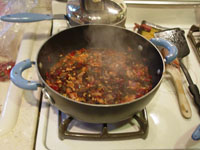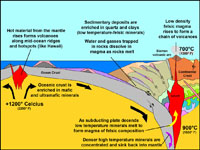4.10: How does Plate Tectonics explain why continental landmasses are so old (compared to ocean crust)?
- Page ID
- 9857
How does Plate Tectonics explain why continental landmasses are so old (compared to ocean crust)?
The interior of the earth is very hot—the source of this heat is thought to be left over from the formation of the planet several billion years ago. As shown in Figure 4.28, the combined effect of the internal heat of the Earth and the force of gravity drive convection currents within the Earth . Heat things up, they expand, become less dense, and the material rises. Cool things down, they condense, increase in density, and the material sinks. This can be easily demonstrated the way hot air balloon rise and fall, or the way currents move when water is heated, or the way currents within a boiling pot of soup rises and sinks when it cools (Figure 4.29).

Figure 4.29. Currents in boiling soup demonstrates convection. The "broth" rises, cools, and sinks (like the formation and destruction ocean crust over time). In contrast, the bubbly "froth" builds up in patches over where cool soup sinks back into the pot. The buildup of froth in patches is similar to the way continents build up over time.
When new ocean crust forms in spreading centers, it is still hot for a time, but it eventually cools by having contact with the cold, deep ocean waters. As a result, old ocean crust is enriched in dense minerals. As it ages, it also absorbs water from the ocean and is becomes blanketed with marine sediments. Where subduction takes place, cold, dense ocean crust sinks back into the mantle. However, as the old crust sinks, it heats up and some of the materials within it melts (assisted by the presence of water and other gases). The materials that melt rise as hot fluids (magma and gases) through the overriding continental crust, forming large magma filled chambers that eventually crystallize into rock at depth, some of which erupts at the surface to form volcanoes. The new rocks that form along the continental margins are less dense than the original oceanic crustal rocks, therefore they eventually isostatically float and rise above the ocean surface, becoming land. Over time, more and more of this lighter rock accumulates first forming volcanic island chains. These volcanic arc and the sediments they shed eventually becomes scraped off and crushed onto the margin of continents—often pushed up as coastal mountain ranges. It this manner, continents grow slowly around their margins in a process called accretion. This process explains why the oldest rocks occur in the shield regions of continents and younger material occurs along continental margins.
Continental Accretion
Accretion is a process by which material is added to a tectonic plate or a landmass. This material may be sediment, volcanic arcs, seamounts or other igneous features, or blocks or pieces of continental crust split from other continental plates (Figure 4.30 to 4-31). Over geologic time (measured in millions of years), volcanic arcs form and may be crushed onto (or between) colliding continents along plate boundaries. Pieces of continental land masses may be ripped away and carried to other locations. For instance, Baja California and parts of southern California west of the San Andreas Fault are being ripped away from the North American continent and are slowly being carried northward. These rocks may eventually pass what-is-now San Francisco, and perhaps 70 to 100 million years from now will be crushed and accreted into the landmass currently known as Alaska!
The entire West Coast of North America is made up of massive fault-bounded blocks of crust (called terranes).A terrane is a fault-bounded area with a distinctive stratigraphy (collection of rocks), structure, and geologic history compared with surrounding terranes or land masses.
Another YouTube video:
Continents Adrift An Introduction to Continental Drift and Plate Tectonics. This video explains much of what this chapter reviews.





